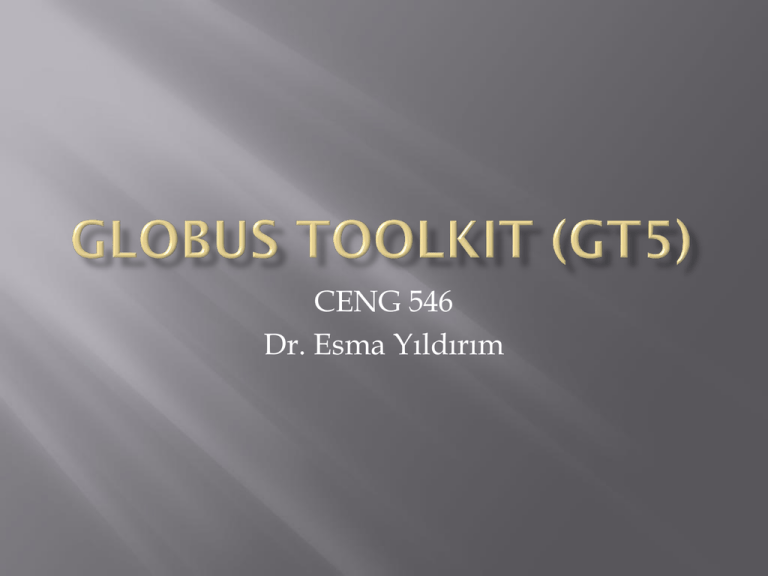globus-job
advertisement

CENG 546 Dr. Esma Yıldırım A fundamental enabling technology for the "Grid," letting people share computing power, databases, and other tools securely online across corporate, institutional, and geographic boundaries without sacrificing local autonomy It includes software services and libraries for resource monitoring, discovery, and management, plus security and file management security, information infrastructure, resource management, data management, communication, fault detection, portability How did Globus become the “de facto standard” for Grid Computing A small team led by Ian Foster at Argonne created new protocols that allowed I-WAY users to run applications on computers across the country at Super Computing 95 The experiment got the attention of DOE and NSF With the funding from many national agencies, it began in 1996. The project has spurred a revolution in the way science is conducted. High-energy physicists designing the Large Hadron Collider at CERN are developing Globus-based technologies through the European Data Grid, and the U.S. efforts like the Grid Physics Network (GriPhyN) and Particle Physics Data Grid. The Grid Resource Allocation and Management (GRAM5) component is used to locate, submit, monitor, and cancel jobs on Grid computing resources. GRAM5 is not a Local Resource Manager, but rather a set of services and clients for communicating with a range of different batch/cluster job schedulers using a common protocol. GRAM 5 Components Gate Keeper Job Manager Scheduler Event Generator LRM Adaptor The globus-gatekeeper service provides a network interface to the GRAM5 system. It authenticates client identities and starts Job Manager processes using the local user account to which the client identity is mapped. One instance of the globus-gatekeeper process runs to accept network connections, and forks a new short-lived process to process each new connection. The globus-job-manager daemon processes job requests and coordinates file transfers. There is one long-lived instance of this per user per LRM and one short-lived instance per job. The globus-scheduler-event-generator process parses LRM-specific data relating to job startup, execution, and termination into an LRM-independent data format. There is optionally one instance of this program per LRM. The LRM adapter provides an interface between the GRAM5 system components and the LRM. It provides concrete implementations of the submit, cancel, and poll functionality for a particular system's LRM and to generate job status change events. GRAM jobs consist of file transfers and program execution on one or more compute elements managed by a local resource manager The GRAM client can submit the job and then later poll for its status, or it can request that the GRAM service notify it when the job changes state or completes. While the job is executing, the client may send control messages to the GRAM service to monitor or modify the job. GRAM provides reliable job submission, job recovery in case of service or client failures, file staging, and asynchronous notification messages. GRAM achieves its uniform interface by implementing a domain-specific language called the Resource Specification Language (RSL) which provides a simple way to express job requirements, environment, and commands in a specification which is independent of the local resource manager which will actually execute the job. GRAM uses a proxy certificate which is a shortterm credential digitally signed by a private key You must first obtain a security credential (.X509 certificate) Before interacting with a GRAM service, you must know its contact address Host name Port No Service Name grid.example.org:2120/jobmanagersge:/C=US/O=Example/OU=Grid/CN=host/ grid.example.org Credential name globus-job-run : waits until the job terminates before exiting and prints job standard output and stderr after the job completes globus-job-submit : submit the job and then exit immediately, printing the job contact to its standard output stream globusrun : Uses RSL language to run jobs Minimal job running % globus-job-run grid.example.org/jobmanager-pbs /bin/hostname node1.grid.example.org submits a single instance of the /bin/hostname executable to the resource named by grid.example.org/jobmanager-pbs Multiprocess job running % globus-job-run grid.example.org/jobmanager-pbs -np 4 /bin/hostname node1.grid.example.org node3.grid.example.org node2.grid.example.org node10.grid.example.org submits ten instances of an executable /bin/hostname. The output of the job is the name of the ten hosts that the job ran on. The -np COUNT option causes globusjob-run to run COUNT instances of the executable. Staging an executable file % globus-job-run grid.example.org/jobmanager-pbs -s my-executable node1.grid.example.org submits an executable which is local to the submit machine to the GRAM resource, then executes it. The executable is removed automatically from the GRAM resource after the job completes. The -s option prior to the executable name causes globus-jobrun to stage the executable using GASS (an https-based protocol) from the machine running globus-job-run to the GRAM resource. Providing an input file to a job % globus-job-run grid.example.org/jobmanager-pbs -stdin inputfile.txt /bin/cat Hello, Grid submits a job to a GRAM resource. When this job runs, its standard input will read from the file $HOME/inputfile.txt, which is located on the GRAM resource. The -stdin command-line option indicates this path. Staging an input file to a job % globus-job-run grid.example.org/jobmanager-pbs -stdin -s inputfile.txt /bin/cat Hello, staged input on the Grid submits a job to a GRAM resource. When this job runs, its standard input will read from the file inputfile.txt, which is located on the submit client machine. The -stdin -s command-line option combination causes the input to be staged in the above executable staging example % globus-job-submit grid.example.org/jobmanager-pbs /bin/hostname https://grid.example.org:38843/16001600430615223386/5295612977486013582/ % globus-job-status https://grid.example.org:38843/16001600430615223386/5295612977486013582/ PENDING % globus-job-status https://grid.example.org:38843/16001600430615223386/5295612977486013582/ ACTIVE % globus-job-status https://grid.example.org:38843/16001600430615223386/5295612977486013582/ DONE % globus-job-get-output -r grid.example.org/jobmanager-fork \ https://grid.example.org:38843/16001600430615223386/5295612977486013582/node1.g rid.example.org % globus-job-clean -r grid.example.org/jobmanager-fork \ https://grid.example.org:38843/16001600430615223386/5295612977486013582/ WARNING: Cleaning a job means: - Kill the job if it still running, and Remove the cached output on the remote resource Are you sure you want to cleanup the job now (Y/N) ? y Cleanup successful. Basic interactive job % globusrun -s -r example.grid.org/jobmanager-pbs "&(executable=/bin/hostname (count=5)” node03.grid.example.org node01.grid.example.org node02.grid.example.urg node05.grid.example.org node04.grid.example.org submit interactive job with globusrun. When the -s is used, the output of the job command is returned to the client and displayed as if the command ran locally. This is similar to the behavior of the globusjob-run program described. Basic batch job % globusrun -b -r grid.example.org/jobmanager-pbs "&(executable=/bin/sleep)(arguments=500)” globus_gram_client_callback_allow successful GRAM Job submission successful https://grid.example.org:38824/16001608125017717261/5295612977486019989/GL OBUS_GRAM_PROTOCOL_JOB_STATE_PENDING % globusrun -status https://grid.example.org:38824/16001608125017717261/5295612977486019989/PE NDING % globusrun -k https://grid.example.org:38824/16001608125017717261/5295612977486019989/ % submit, monitor, and cancel a batch job using globusrun. This method is useful for the case where the job may run for a long time, the job may be queued for a long time, or when there are network reliability issues between the client and service One of the foundational issues in HPC computing is the ability to move large (multi Gigabyte, and even Terabyte), file-based data sets between sites. Simple file transfer mechanisms such as FTP and SCP are not sufficient either from a reliability or performance perspective. GridFTP extends the standard FTP protocol to provide a high-performance, secure, reliable protocol for bulk data transfer Performance - GridFTP protocol supports using parallel TCP streams and multi-node transfers to achieve high performance. Checkpointing - GridFTP protocol requires that the server send restart markers (checkpoint) to the client. Third-party transfers - The FTP protocol on which GridFTP is based separates control and data channels, enabling third-party transfers, that is, the transfer of data between two end hosts, mediated by a third host. Security - Provides strong security on both control and data channels. Control channel is encrypted by default. Data channel is authenticated by default with optional integrity protection and encryption. A server implementation called globus-gridftpserver, A scriptable command line client called globusurl-copy, A set of development libraries for custom clients. globus-url-copy –vb -p 4 source_url destination_url -vb -> outputs transfer performance -p -> sets the number of parallel streams globus-url-copy -vb -p 4 -r -cd - cc 4 source_url destination_url Directory transfer -r -> copy files in sub directories -cd -> create destination directory -cc -> number of concurrent connections Source and Destination URLs file:///path/to/my/file if you are accessing a file on a file system accessible by the host on which you are running your client. gsiftp://hostname/path/to/remote/file if you are accessing a file from a GridFTP server. Uploading a File Downloading a File globus-url-copy -vb -p 4 file:///tmp/foo gsiftp://remote.machine.my.edu/tmp/bar globus-url-copy -vb -p 4 gsiftp://remote.machine.my.edu/tmp/bar file:///tmp/foo Third party Transfers globus-url-copy -vb -p 4 gsiftp://other.machine.my.edu/tmp/foo gsiftp://remote.machine.my.edu/tmp/bar Job Submission Data Transfer GRAM GridFTP Security GSI -> Coming Soon








